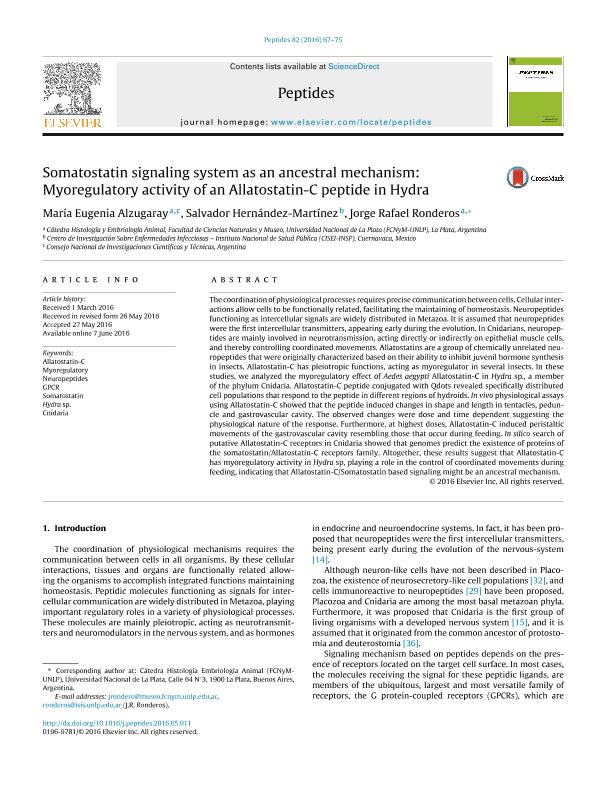Mostrar el registro sencillo del ítem
dc.contributor.author
Alzugaray, Maria Eugenia

dc.contributor.author
Hernández Martínez, Salvador
dc.contributor.author
Ronderos, Jorge Rafael

dc.date.available
2018-08-08T18:38:14Z
dc.date.issued
2016-08
dc.identifier.citation
Alzugaray, Maria Eugenia; Hernández Martínez, Salvador; Ronderos, Jorge Rafael; Somatostatin signaling system as an ancestral mechanism: Myoregulatory activity of an Allatostatin-C peptide in Hydra; Elsevier Science Inc; Peptides; 82; 8-2016; 67-75
dc.identifier.issn
0196-9781
dc.identifier.uri
http://hdl.handle.net/11336/54633
dc.description.abstract
The coordination of physiological processes requires precise communication between cells. Cellular interactions allow cells to be functionally related, facilitating the maintaining of homeostasis. Neuropeptides functioning as intercellular signals are widely distributed in Metazoa. It is assumed that neuropeptides were the first intercellular transmitters, appearing early during the evolution. In Cnidarians, neuropeptides are mainly involved in neurotransmission, acting directly or indirectly on epithelial muscle cells, and thereby controlling coordinated movements. Allatostatins are a group of chemically unrelated neuropeptides that were originally characterized based on their ability to inhibit juvenil hormone synthesis in insects. Allatostatin-C has pleiotropic functions, acting as myoregulator in several insects. In these studies, we analyzed the myoregulatory effect of Aedes aegypti Allatostatin-C in Hydra sp., a member of the phylum Cnidaria. Allatostatin-C peptide conjugated with Qdots revealed specifically distributed cell populations that respond to the peptide in different regions of hydroids. In vivo physiological assays using Allatostatin-C showed that the peptide induced changes in shape and length in tentacles, peduncle and gastrovascular cavity. The observed changes were dose and time dependent suggesting the physiological nature of the response. Furthermore, at highest doses, Allatostatin-C induced peristaltic movements of the gastrovascular cavity resembling those that occur during feeding. In silico search of putative Allatostatin-C receptors in Cnidaria showed that genomes predict the existence of proteins of the somatostatin/Allatostatin-C receptors family. Altogether, these results suggest that Allatostatin-C has myoregulatory activity in Hydra sp, playing a role in the control of coordinated movements during feeding, indicating that Allatostatin-C/Somatostatin based signaling might be an ancestral mechanism.
dc.format
application/pdf
dc.language.iso
eng
dc.publisher
Elsevier Science Inc

dc.rights
info:eu-repo/semantics/openAccess
dc.rights.uri
https://creativecommons.org/licenses/by-nc-sa/2.5/ar/
dc.subject
Allatostatin-C
dc.subject
Cnidaria
dc.subject
Gpcr
dc.subject
Hydra Sp.
dc.subject
Myoregulatory
dc.subject
Neuropeptides
dc.subject
Somatostatin
dc.subject.classification
Otras Ciencias Biológicas

dc.subject.classification
Ciencias Biológicas

dc.subject.classification
CIENCIAS NATURALES Y EXACTAS

dc.title
Somatostatin signaling system as an ancestral mechanism: Myoregulatory activity of an Allatostatin-C peptide in Hydra
dc.type
info:eu-repo/semantics/article
dc.type
info:ar-repo/semantics/artículo
dc.type
info:eu-repo/semantics/publishedVersion
dc.date.updated
2018-08-08T16:37:20Z
dc.journal.volume
82
dc.journal.pagination
67-75
dc.journal.pais
Estados Unidos

dc.journal.ciudad
Nueva York
dc.description.fil
Fil: Alzugaray, Maria Eugenia. Consejo Nacional de Investigaciones Científicas y Técnicas; Argentina. Universidad Nacional de la Plata. Facultad de Ciencias Naturales y Museo. Cátedra de Histología y Embriología Animal; Argentina
dc.description.fil
Fil: Hernández Martínez, Salvador. Instituto Nacional de Salud Pública; México
dc.description.fil
Fil: Ronderos, Jorge Rafael. Consejo Nacional de Investigaciones Científicas y Técnicas; Argentina. Universidad Nacional de la Plata. Facultad de Ciencias Naturales y Museo. Cátedra de Histología y Embriología Animal; Argentina
dc.journal.title
Peptides

dc.relation.alternativeid
info:eu-repo/semantics/altIdentifier/doi/https://dx.doi.org/10.1016/j.peptides.2016.05.011
dc.relation.alternativeid
info:eu-repo/semantics/altIdentifier/url/https://www.sciencedirect.com/science/article/pii/S0196978116301188
Archivos asociados
